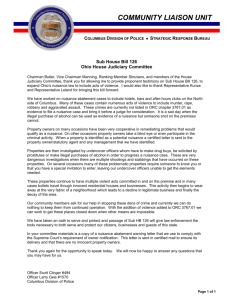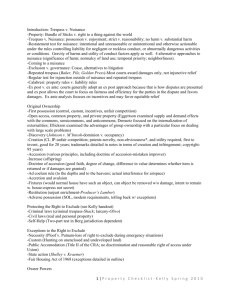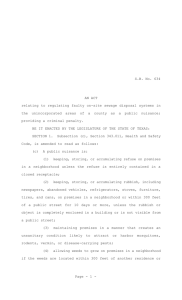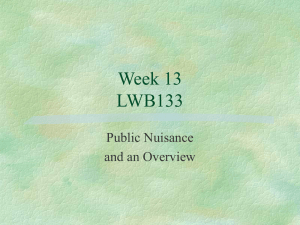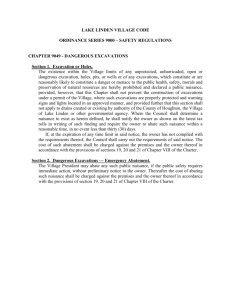An Agricultural Law Research Article Nuisance Revisited After
advertisement
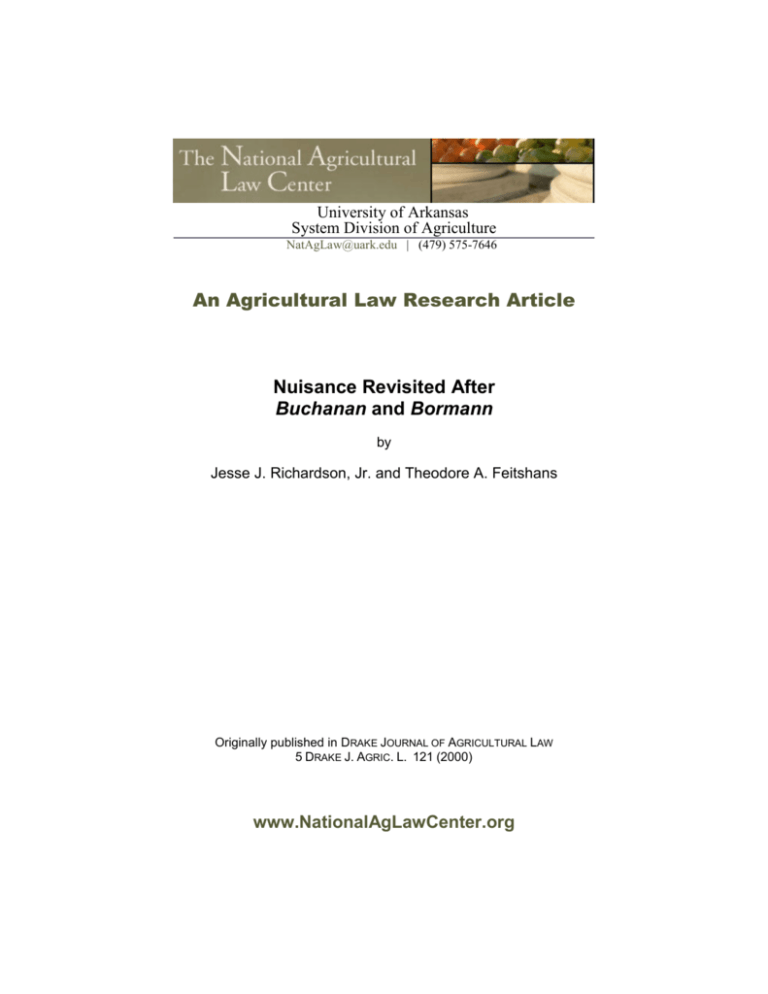
University of Arkansas System Division of Agriculture NatAgLaw@uark.edu | (479) 575-7646 An Agricultural Law Research Article Nuisance Revisited After Buchanan and Bormann by Jesse J. Richardson, Jr. and Theodore A. Feitshans Originally published in DRAKE JOURNAL OF AGRICULTURAL LAW 5 DRAKE J. AGRIC. L. 121 (2000) www.NationalAgLawCenter.org NUISANCE REVISITED AFTER BUCHANAN AND BORMANN Jesse J. Richardson, Jr.· & Theodore A. Feitshans·· I. II. m. N. V. VI. VII. vm. httroduction Nuisance Generally Legislative Changes of Common Law Nuisance Granting of Permanent Damages as Condemnation Brief Overview of Right to Fann Laws Borman v. Board o/Supervisors o/Kossuth County, Iowa Buchanan v. Simp/ot Feeders Limited Partnership and IBP Conclusion 121 122 125 127 127 129 133 135 "There is perhaps no more impenetrable jungle in the entire law than that which surrounds the word 'nuisance.' ... [F]ew terms have afforded so excellent an illustration of the familiar tendency of the courts to seize upon a catchword as a substitute for any analysis of a problem.'" I. INTRODUCTION Two recent cases involving state Right to Fann Acts2 have drawn the attention oflegal scholars, attorneys and laymen alike to the common law doctrine of nuisance. Both cases found that the Right to Fann Acts in question constituted a legislatively imposed easement across the property of affected landowners. 3 One court went on to opine that this imposition constituted a "physical invasion" of the * Jesse J. Richardson, Jr. is an assistant professor in the Department of Urban Affairs and Planning at Virginia Tech in Blacksburg, Virginia. He received his B.S. and M.S. in Agricultural and Applied Economics from Virginia Tech. He holds a J.D. from the University of Virginia School of Law. ** Theodore A. Feitshans is an Extension Specialist and Lecturer in the Department of Agricultural and Resource Economics at North Carolina State University in Raleigh, North Carolina. He received his B.S. in Animal Science from Cornell University and his M.S. in Agricultural and Applied Economics from the University of Minnesota. He holds a J.D. from Georgetown University. I. W. PAGE KEETON, ET AL, PROSSER AND KEETON ON THE LAW OF TORTS §86, at 616 (5th ed. 1984). 2. See Bormann v. Board of Supervisors, 584 N.W.2d 309 (Iowa 1998); Buchanan v. Simplot Feeders, Ltd. Partnership, 952 P.2d 610 (Wash. 1998); Buchanan v. Simplot Feeders, Ltd. Partnership, No. CS-95-236-FVS, 1998 U.S. Dist. LEXIS 21780 (E.D. Wash.). 3. See Bormann, 584 N.W.2d at 316; Buchanan, 1998 U.S. Dist. LEXIS 21780 at *1-2. 121 122 Drake Journal ofAgricultural Law [Vol. 5 affected property owner's land, and thus a categorical taking of private property for public purposes without just compensation.4 This article examines the underpinnings of nuisance as established by judicial opinions and buttressed by the Second Restatement of Torts and other scholarly writings.' An in-depth discussion of two recent cases is given folIowed by a comparison of the case opinions to the fundamental underpinnings of nuisance law.' Upon analysis neither opinion should be considered surprising or extraordinary, given the history ofnuisance. n. NUISANCE GENERALLY As a general rule, an owner is at liberty to use his property as he sees fit, without objection or interference from his neighbor, provided such use does not violate an ordinance or statute. There is, however, a limitation to this rule; one made necessary by the intricate, complex, and changing life of today. The old and familiar maxim that one nmst so use his property as to not injure that of another ... is deeply imbedded in our law.' The general rule that no one has absolute freedom in the use of his property, but is restrained by the coexistence of equal rights in his neighbor to the use of his property, so that each, in exercising his right, nmst do no act which causes injury to his neighbor, is so well understood, is so universally recognized, and stands so impregnably in the necessities of the social state, that its vindication by argument would be superfluous.· ''Nuisance'' may be defined as: interference with an owner's reasonable use and enjoyment of his property by means of smoke, odors, noise or Vibration, obstruction of private easements and rights of support, interference with public rights, such as free passage along streams and highways, enjoyment of public parks and places 4. See Bormann 584 N.W.2d at 321. The Bormann opinion refers to these types of takings as per se takings, apparently adopting the taxonomy of the plaintiffs. See id. at 313. The court in Lucas v. South Carolina Coastal Council, both the majority and dissent, refers to these types of takings as categorical takings. See Lucas v. South Carolina Coastal Council, 50S U.S. 1003, lOIS, 1050 (1992). This article retains the Lucas taxonomy. 5. See discussion infra Parts II-IV. 6. See discussion infra Parts VI-VII. 7. Bove v. Donner-Hanna Coke Corp., 258 N.Y.S. 229, 231 (1932). 8. Booth v. Rome, W. & O.T.R. Co., 35 N.E. 592, 594 (N.Y. 1893). Recent Developments in Iowa Nuisance Law 2000] 123 of recreation, and, in addition, activities and structures prohibited as statutory nuisances. 9 A nuisance may be classified as a "public nuisance" or a ''private nuisance."10 A public nuisance consists of "an unreasonable interference with a right common to the general public."11 A nontrespassory interference with another's interest in the private use and quiet enjoyment of their land constitutes a private nuisance. 12 To subject a person to liability for private nuisance, his conduct must be a legal cause of the interference in someone else's private use interest and quiet enjoyment of their land. 13 In addition, the interference must be either: (i) intentional and unreasonable; or (ii) unintentional, but "otherwise actionable under the rules controlling liability for negligent or reckless conduct, or for abnormally dangerous conditions or activities."14 An intentional interference (or invasion) with another's interest in the use of land is unreasonable if: (i) "the gravity of the harm outweighs the utility of the actor's conduct," or, (ii) "the harm caused by the conduct is serious and the financial burden of compensating for this and similar harm to others would not make the continuation ofthe conduct not feasible."J5 In determining the gravity of the harm from an intentional invasion of another's interest in the use and enjoyment of land, the following factors are important: (i) the extent of the harm involved; (ii) the character of the harm involved; (iii) the social value that the law attaches to the type of use or enjoyment invaded; (iv) the suitability of the particular use or enjoyment invaded to the character of the locality; and (v) the burden on the person harmed of avoiding the harm. 16 The following factors weigh heavily in determining the utility of the conduct that causes the invasion of another's interest in the use and enjoyment of land: (i) the social value that the law attaches to the primary purpose of the conduct; (ii) the suitability of the conduct to the character of the locality; and (iii) the impracticability of preventing or avoiding the invasion. 17 The law of nuisance plys [sic] between two antithetical extremes: The principle that every person is entitled to use his property for any purpose 9. 10. 11. 12. 13. 14. IS. 16. 17. BLACK'S LAw DIC'IlONARY 961 (5th ed. 1979). See REsTATEMBNT(SBCOND) OF TORTS § 821A (1979). Id. § 821B. See id. § 8210. See id. § 822. Id. Id. § 826. See id. § 827. See id. § 828. 124 Drake Journal ofAgricultural Law [Vol. 5 that he sees fit, and the opposing principle that everyone is bound to use his property in such a manner as not to injure the property or rights of his neighbor. For generations, courts, in their tasks of judging, have ruled on these extremes according to the wisdom of the day, and many have recognized that the contemporary view of public policy shifts from generation to generation. 18 An unreasonable interference fmding is not a question of law but a question of fact for the jury.19 Once a nuisance has been determined to exist an appropriate remedy must be found. A different, but similar, balancing process guides the court in fashioning a remedy. Many courts balance "hardships" or "equities" in determining whether to enjoin the nuisance or to grant a judgment for damages.:ZO Much confusion regarding nuisance law results from the tendency of courts to jumble both balancing tests (unreasonable interference and remedy) together into one analysis. The fact that courts consider many of the same factors in each balancing test blurs the lines further. The North Carolina Court of Appeals clearly sets out the distinction between the two different balancing tests in Parker v. Barefoot. 21 If a trier of fact determines that a defendant's conduct is indeed an unreasonable interference with another's use and enjoyment of their land, then the plaintiff is entitled to damages. . .. To award damages, the defendant's conduct, in and of itself, does not need to be unreasonable... In contrast, however, injunctive relief requires proof that the defendant's conduct itself is unreasonable.,,22 This analysis differentiates the two balancing tests on the basis of distinguishing the unreasonableness of the consequences of the defendant's actions versus the unreasonableness of the defendant's actions themselves. 23 18. Antonik v. Chamberlain, 78 N.E.2d 752, 759 (Ohio Ct. App. 1947). 19. See Parker v. Barefoot, 502 S.E.2d 42, 46 (N.C. Ct. App. 1998) rev'd, 519 S.E.2d 315 (N.C. 1999); KEETON ET AL., supra note 1, § 88, at 629 & n.27. While the North Carolina Supreme Court later reversed the holding, the analysis of the court continues to be valid. See Parker v. Barefoot, 519 S.E.2d 315 (N.C. 1999). 20. See ROBERT R. WRIGIIT & MORTON GITBLMAN, CASES AND MATERIALS ON LAND USE 48­ 49 (5th ed. 1997). 21. See Parhr, 502 S.E.2d at 44. Note that the Parhr case involved an intensive hog facility and the failure of the trial court to explicitly instruct the jury that "the law does not recognize as a defense to [nuisance claims] that defendants used the best technical knowledge available at the time to avoid or alleviate the nuisance ...." [d. 22. [d. at 46. 23. See KEETON ET AL., supra note \, § 87, at 623 (emphasis added). 2000] Recent Developments in Iowa Nuisance Law m. 125 LEGISLATIVE CHANGES OF COMMON LAW NUISANCE As recognized by Justice Holmes: [ilt is settled that within constitutional limits not exactly determined the legislature may change the common law as to nuisances and may move the line either way so as to make things nuisances which were not so, or to make things lawful which were nuisances, although by so doing it affects the use or value ofproperty.24 Similarly, the zoning classification or the fact that the disputed use has been granted a govemmentallicense provides persuasive, but not conclusive, evidence for the trier offact,2S Nevertheless, Constitutional underpinnings make courts reluctant to license a nuisance. 26 The United States Supreme Court, in Richards v. Washington Terminal Company,27 considered the question of legislative legalization of a private nuisance. 28 In Richards, the plaintiff filed suit under a nuisance theory to recover for damages resulting from the operation of a railroad and tunnel by defendant. 29 Plaintiff alleged that the operation of the railroad and tunnel amounted to a private nuisance. 3o Plaintiffs property did not adjoin that of the defendant,31 Two sets of railroad tracks ran through and from the tunnel at issue. 32 The defendant installed a fanning system in the tunnel that caused the gases and smoke (emitted by the trains while in the tunnel) to be forced out of the south portaP3 About thirty trains per day used the tracks. 34 From the closest point of the plaintiffs home to the south portal, the distance totaled about one hundred fourteen feet, while the rear end of plaintiffs lot lay about ninety feet from the middle of the tracks. 3' Three houses stood between plaintiffs property and the railroad tracks, two of which were purchased and owned by the defendant, 36 24. Commonwealth v. Parks, 30 N.E. 174, 174 (Mass. 1892). 25. See JUUAN CONRAD JUERGENSMEYER & THOMAS E. ROBERTS, LAND USE PLANNING AND CoNTROL LAW § 14.7, at 646-47 (1998); Maykut v. Plasko, 365 A.2d 1114, 1118 (Conn. 1976). 26. See JUERGENSMEYER & ROBERTS, supra note 24, § 14.7, at 647. 27. Richards v. Washington Tenninal Co., 233 U.S. 546 (1914). 28. See id. at 548. 29. Seeid. 30. See id. at 549-50. 31. See id. at 548. 32. See id. at 549. 33. See id. 34. Seeid. 35. See id. 36. See id. Drake Journal ofAgricultural Law 126 [Vol. 5 The large amounts of black or gray smoke, dust, dirt, cinders and gases emitted by the trains as they passed, as well as vibrations from the trains, damaged plaintiff's property.37 The fair market value of the property, the rental value and the value of the personal property within the house depreciated as a result of the railroad operation. 38 One significant point on which the court appeared to rely was that the plaintiff conceded that the railroad was not operated negligently and that Congress authorized the operation. 39 The Court held that the damages resulting from the plaintiffs close proximity to the portal and the fanning system's gas discharge effect and smoke imposed "so direct and peculiar and substantial a burden upon plaintiffs property" as to violate the Fifth Amendment's prohibition against the taking of private property for public purposes without just compensation.40 The Court, in dicta, stated that "while the legislature may legalize what otherwise would be a public nuisance, it may not confer immunity from action for a private nuisance of such a character as to amount to a taking of private property for public use."41 Juergensmeyer and Roberts discuss this issue in terms of the Right to Farm Acts. 42 These authors generally dismiss the notion that Right to Farm Acts can constitute a taking of private property for public purposes. 43 However, they acknowledge that: [t]he immunity in effect confers an affmnative easement on the farmer to cast pollutants of odors, noise, or dust, as the case may be, on the neighbors land. If this is characterized as a physical invasion, then the prospects in a taking claim look brighter, but it is not clear that a court would so regard it. 44 37. 38. 39. 40. See id. See id. at 550. See id. Id. at 557. 41. Id. at 553. 42. See JUERGENSMEYER & ROBERTS, supra note 25, § 14.7, at 647 & n.18 (suggesting that Right to Farm Acts may constitute a taking of private property for public purposes without just compensation). 43. See id. § 14.7, at 647-48. 44. Id. § 14.7, at 648. 2000] Recent Developments in Iowa Nuisance Law IV. 127 GRANTING OF PERMANENT DAMAGES AS CONDEMNATION The seminal case, Boomer v. Atlantic Cement Company,4S a case that all law students read in torts class, involved a large cement plant near Albany, New York.46 The neighboring landowners alleged a nuisance from the resulting dirt, smoke and vibration emanating from the plant.47 The court below found a nuisance after trial and granted temporary damages, while denying injunctive reIief.48 The New York Court of Appeals remitted the case to the Supreme Court of Albany County ''to grant an injunction which shall be vacated upon payment by defendant of such amounts of permanent damage to the respective plaintiffs as shall for this purpose be determined by the COurt."49 The court acknowledged that, "[t]he theory of damage is the 'servitude on the land' of plaintiffs imposed by defendant's nuisance."so A servitude is a charge or burden resting upon one estate for the benefit of another. s • A vigorous dissent took issue with the ramifications of the permanent damages remedy in this instance. Judge Jasen felt that, [i]n permitting the injunction to become inoperative upon the payment of permanent damages, the majority is, in effect, licensing a continuing wrong. . . This kind of inverse condemnation [citation omitted] may not be invoked by a private person or corporation for private gain or advantage... Nor is it constitutionally permissible to impose servitude on land, without the consent of the owner, by payment of permanent damages where the continuing impairment of the land is for a private use. S2 V. BRIEF OVERVIEW OF RIGHT TO FARM LAWS All states and some local governments employ some form of a Right to Farm Act to protect working lands from the encroachment of residential development. Right to Farm statutes were created to address a growing concern that too much farmland was being overtaken by urban sprawL s3 As more urban dwellers moved into agricultural areas, "nuisance" lawsuits by those urbanites threatened the 45. Boomer v. Atlantic Cement Co., 257 N.E.2d 870 (N.Y. 1970). 46. See id. at 871-872. 47: See id. at 871. 48. See id. 49. Id. at 875. 50. Id. (citing United States v. Causby, 328 U.S. 256,261 (1946)). 51. See BLACK'S LAW DICTIONARY 1229 (5th ed. 1979). 52. Id. 53. See Margaret Rosso Grossman & Thomas G. Fischer, Protecting the Right to Farm: Statutory Limits on Nuisance Actions Against the Farmer, 1 WIS. L. REv. 95, 97-98 (1983). Drake Journal ofAgricultural Law 128 [Vol. 5 existence of many fanns. 54 Nuisance suits frustrated fanning operations and encouraged farmers to sell to developers, continuing the cycle." Right to Farm laws may be categorized generally into six different types: (i) traditional; (ii) laws requiring the use of GAAMP's; (iii) laws listing specific protected agricultural activities; (iv) laws protecting animal feedlots; (v) laws requiring creation of agricultural districts; and (vi) local ordinances. 56 Traditional Right to Farm laws basically protect fann operations that existed prior to residential encroachment." These laws codify the "coming to the nuisance" defense. 58 Activities that are negligently run are not afforded the protection of Right to Farm. 59 The "coming to the nuisance" defense suggests that the "first one to arrive fixes forever the character of the area.''60 However, some courts refuse to recognize the defense. 61 Those courts recognizing the defense of coming to the nuisance merely use it as a factor to consider.62 The prevailing rule provides that, absent a prescriptive right, the defendant may not condemn the surrounding premises to endure his operation, and that the purchaser is entitled to a reasonable use and enjoyment of his land to the same extent as any other owner, so long as he buys in good faith and not for the sole purpose of vexatious lawSuit. 63 Spur Industries, Inc. v. Del E. Webb Development Company,64 though recognizing this principle, put a new twist on the remedies question.6' Spur remains the landmark remedies case in nuisance, also read, like Boomer, by all law students. Webb, a real estate developer, brought a nuisance action against Spur, who ran a cattle-feeding operation.66 Spur commenced the cattle feeding operations in an agricultural area well outside boundaries of any city.67 Subsequently, Webb purchased land nearby and commenced an extensive retirement community See id. at 97. See id. See NEIL D. HAMILTON, A LIVESTOCK PRODUCER'S LEGAL GUIDE To: NUISANCE, LAND USE CoNTROL, AND ENVIRONMENTAL LAW 24 (1992). 57. See JUERGENSMEYER & ROBERTS, supra note 25, § 14.6, at 645. 58. See id. 59. See id. 60. [d. § 14.4, at 640 & n.lO. 61. See id. § 14.4, at 640 & n.9. 62. See id. § 14.4, at 640 & n.1 O. 63. KEETON ET AL., supra note I, § 888, at 635. 64. Spur Indus., Inc. v. Del E. Webb Dev. Co., 494 P.2d 700 (Ariz 1972). 65. See id. at 707. 66. See id. at 705. 67. See id. at 704. 54. 55. 56. Recent Developments in Iowa Nuisance Law 2000] 129 development. 68 The Supreme Court of Arizona held that Webb was entitled to enjoin Spur's cattle feeding operation as a nuisance. 69 However, the court further held that Webb had "brought people to the nuisance to the foreseeable detriment of Spur."70 Therefore, the court ordered Webb to indemnify Spur for a reasonable amount of the cost of moving or shutting down. 71 One may argue that the court in Spur allowed the plaintiff to "condemn the surrounding premises to endure his operation."72 The second type of Right to Farm law protects farmers who use Generally Accepted Agricultural Management Practices (GAAMPS).73 The third type of right to farm law specifically lists certain agricultural practices. 74 For example, a law may list odors from livestock, manure, fertilizer or feed as protected. 7' Some laws also protect feedlots specifically. Other forms of Right to Farm laws provide different legal protections to farm operations located within a designated agricultural district,76 Finally, some local governments have passed Right to Farm ordinances. Most of these ordinances are similar to the traditional Right to Farm laws, but many local governments have passed innovative Right to Farm ordinances.77 VI. BORMANN V. BOARD OF SUPERVISORS OF KOSSUTH COUNTY, IOWA In Bormann v. Board ofSupervisors, 78 the Iowa Supreme Court held that one Iowa Right to Farm law constituted a taking of private property from the neighbor of the farmer for public purposes without just compensation. 79 The defendants applied to their local county Board of Supervisors for approval of an "agricultural area" they wanted to establish. so The proposed agricultural area included the land of several neighbors as well as that of the defendants. 81 The agricultural area proposed encompassed 960 acres and the Board subsequently approved the application.82 68. See id. 69. See id. at 706. 70. Id. at 708. 71. See id. 72. KEETON ET AL., supra note I, § 88B, at 635. 73. See HAMILTON, supra note 56, at 25. 74. See id. at 26. 75. See Spur Indus., Inc., 494 P.2d at 708. 76. See HAMILTON, supra note 56, at 27. 77. See id. at 28. 78. Borman v. Board of Supervisors, 584 N. W.2d 309 (Iowa 1998). 79. See id. at 311. 80. See id. 81. See [d. 82. See id. at 312. The approval actually occurred on the second application. See id. at 311­ 12. For procedural reasons, a third vote was necessary. See id. at 312. None of these procedural issues affected the substance of this case. Drake Journal ofAgricultural Law 130 [Vol. 5 An agricultural area in Iowa includes, among other activities: raising and storing of crops; the care and feeding of livestock; the treatment or disposal of waste resulting from livestock; and the creation of noise, odor, dust or fumes. 83 Iowa law further provides that a farm or farm operation located in an agricultural area does not constitute a nuisance.... This classification holds regardless of the established date of operation or the date of the agricultural activities expansion of the farm or farm operation. 85 This immunity from nuisance suits does not apply to nuisances resulting from: (i) a violation of a federal law or regulation; (ii) a violation of a state law or rule; (iii) the negligent operation of a farm or farm operation; (iv) an injury to a person or damage to property caused by the farm or a farm operation prior to creation of the agricultural area; or (v) an injury or damages sustained by the person bringing suit "because of pollution or change in condition of the waters of a stream, the overflowing of the person's land, or excessive soil erosion onto another person's land, unless the injury or damage is caused by an act ofOod."86 The Iowa Code defines nuisance as "whatever is injurious to health, indecent, or unreasonably offensive to the senses, or an obstruction to the free use of property, so as essentially to unreasonably interfere with the comfortable enjoyment oflife or prOperty."8' Iowa Code section 657.2 lists certain activities that constitute a nuisance:88 1. The erecting, continUing, or using of any building or other place for the exercise of any trade, employment, or manufacture, which, by occasioning noxious exhalations, unreasonably offensive smells, or other annoyances, becomes injurious and dangerous to the health, comfort, or property of individuals or the public. 2. The causing or suffering any offal, filth, or noisome substance to be collected or to remain in any place to the prejudice of others. ••• 4. The corrupting or rendering unwholesome or impure the water of any river, stream, or pond, or unlawfully diverting the same from its natural course or state, to the injury or prejudice of others. 89 83. 84. 85. 86. 87. 88. 89. See IOWA CODE § 352.2(6) (1999). See id. § 352.1 1(I)(a). See id. [d. § 352.11(1)(b). [d. § 657.1. See id. § 657.2. [d. Recent Developments in Iowa Nuisance Law 2000] 131 Note that this statutory definition of nuisance does not modify cotmllon law nuisance. 90 The COtml1on law fills in the gaps of the statute. With this background, the court in Bormann addressed whether the Right to Fann law at issue in that case constituted an unlawful "taking. "91 The Fifth Amendment of the U.S. Constitution provides that private property [shall not] be taken for public use, without just compensation.''92 The United States Supreme Court has fashioned a test to determine whether a government regulation exacts a taking of private property without just compensation.93 An interpretation of the test delineated in Lucas follows: A. Is the purpose of the regulatory action a legitimate state interest?94 1. if yes, go to B.; 2. ifno, a compensable taking has occurred.9s B. Does the means used to achieve the objective substantially advance the intended state purpose?96 1. if yes, go to C.; 2. ifno, a compensable taking has occurred. 97 C. Does the alleged taking compel the property owner to suffer a physical invasion of his property (or the equivalent)?98 1. if yes, a compensable taking has occurred;99 2. ifno, go to D. D. "No economically viable use" test 100 1. Does the alleged taking deny the property owner of all economically beneficial or productive use of the land?lol i. if yes, go to 2.; ii. if no, go to E. 2. Does the regulation simply make explicit what already inheres in the title itself, in the restrictions that the background 90. 9t. 92. 93. 94. 95. 96. 97. 98. 99. 100. lOt. See Bormann v. Board of Supervisors. 584 N.W.2d 309, 314 (Iowa 1998). See id. at 315. U.S.CoNST.arnend.V. See Lucas v. South Carolina Coastal Council, 505 U.S. 1003, 1030-32 (1992). See id. at 1014-15. See id. at 1015. See id. at 1024. See id. at 1026. See id. at 1015. See id. See id. at 1016-1019. See id. at 1016. Drake Journal ofAgricultural Law 132 [Vol. 5 principles of the state's law of nuisance already imposed on the landowner?102 i. if yes, go to E.; ii. if no, a compensable taking has occurred.103 E. Apply the Penn Central balancing test,I04 balancing: 1. the economic impact of the regulation on the landowner; 105 2. the landowner's investment backed expectations;l06 and, 3. the character of the government activity.107 In applying the Lucas test, the Iowa Supreme Court declared that under Iowa law, the right to maintain a nuisance suit is an easement. IOB An easement is an interest in land that entitles the owner of the easement to use or enjoy land in the possession of another. 109 A right of way for ingress or egress is a common type of easement. The Court found that the Board's approval of the application for an agricultural area triggered the provisions of the state statute affording the applicants immunity from nuisance suitS. 1lO This immunity resulted in the Board's taking of easements in the neighbors' properties for the benefit of the applicants. This amounts to a taking of private property for public use without payment of compensation in violation of the Fifth Amendment to the Federal Constitution. This also amounts to a taking of private property for public use in violation of article 1, section 18 of the Iowa Constitution. 11 I 102. 103. 104. (1978). See id. at 1028-29. See id. at 1029. See id. at 1017-18; Penn Cent. Transp. Co. v. City of New York, 438 U.S. 104,124 105. 106. 107. 108. 109. 110. See Penn Cent. Transp. Co., 438 U.S. at 124. See id. See Lucas, 505 U.S. at 1030-32; Penn Cent. Transp. Co., 438 U.S. at 124. See Bormann v. Board of Supervisors, 584 N.W.2d 309, 315 (Iowa 1998). See REsTATEMENT OF PROPERTY § 451, cmt. a (1944). See Bormann, 584 N.W.2d at 321. Ill. Id. Note that the language of the Iowa Supreme Court's holding also implies that a taking could be found under the first prong of the Lucas test. See id. Namely, if the easement was for the "benefit of the applicant," the governmental action appears to lack a proper purpose. See id. The Iowa Supreme Court goes on to state that the action was for "public use," however, with no explanation. See id. Contrast this approach with the Boomer dissent. See discussion supra Part IV. Recent Developments in Iowa Nuisance Law 2000] 133 By taking this easement from the neighboring landowners, the action of the Board essentially physically invaded the neighbors property.tl2 The state now allowed the farmer to conduct activities that constituted a nuisance, where the farmer was not allowed to conduct these activities in the past. tI3 In other words, the Iowa Supreme Court reasoned that this law took one of the sticks (the right to not be subject to unreasonable interference with the reasonable use of your land) from the bundle representing the property rights of the farmer's neighbor. Thus, the third prong of the takings test, as set out previously, had been 114 met. This step constitutes a categorical taking; meaning that no further inquiry is necessary to determine if the action amounts to a taking of private property for public purposes without just compensation.tu The Bormann court cited Richards v. Washington Terminal Company\l6 in which the United States Supreme Court neither explicitly reasoned that the right to maintain a nuisance suit was an easement, nor discussed easements as physical invasions. 1I7 However, the definitions of nuisance and easement lend themselves to the categorization. The categorical rule of takings for physical invasion easily applies to easements. Therefore, the Bormann result and reasoning comports with the United States Supreme Court's decision in Richards. Similarly, the Bormann result adheres to hornbook land use law as recognized by Justice Holmes in Commonwealth v. Parks, \18 over 100 years ago. vn. BUCHANAN Y. SIMPLOTFEEDERS LIMITED PARTNERSHIP AND IBP Another court decision, from Washington state, raises further concerns about the constitutionality of Right to Farm Acts across the country. Buchanan v. Simplot Feeders Limited Partnership and IBptt9 involved judicial opinions by the Supreme Court of Washington and the United States District Court for the Eastern District of Washington. 120 112. See Borman, 584 N.W.2d at 317-21. 113. Seeid.at316. 114. See id. at 317-21. lIS. See id. at 321. 116. Richards v. Washington Tenninal Co., 233 U.S. 546 (1914). 117. See id. at 546-58. 118. See Commonwealth v. Parks, 30 N.E. 174, 174 (Mass. 1892). See Buchanan v. Simplot Feeders, Ltd. Partnership, 952 P.2d 610, 612 (Wash. 1998); 1I9. Buchanan v. Simplot Feeders, Ltd. Partnership, No. CS-95-236-FVS 1998 U.S. Dist. LEXIS 21780, at ·1 (E.D. Wash. May 29, 1998). 120. See Buchanan, 952 P.2d 610; Buchanan, 1998 U.S. Dist. LEXIS 21780, at·1. Drake Journal ofAgricultural Law 134 [Vol. 5 The Buchanans purchased a fann in 1960 and began farming in 1961. 121 The fann grew alfalfa, row crops, orchard fruit and melons" 22 In 1969, a small feedlot was developed on adjoining property that was previously rangeland. 123 In 1970, a beef processing plant was built near the feedlot. l24 In 1979, ffiP installed a wastewater lagoon system. The system was in compliance with government permits, but it was uncontroverted that it emitted odors. In 1983, ffiP obtained approval to expand its wastewater system. In 1993, ffiP obtained approval to again expand its wastewater system by replacing the existing lagoon with a larger one covering forty acres. In 1995, ffiP obtained approval to expand the sprayfield on which it [placed] wastewater, from 255 acres to 1,538 acres. l25 In 1992, Simplot purchased the feedlot and substantially expanded operations to 580 acres of pens holding an estimated 40,000 head of cattle. l26 Like ffiP, Simplot was in compliance with the applicable county permits and regulations for the land. 127 Plaintiffs complained that manure, dust, and fly infestations from the defendants' land ruined their crops.128 Furthermore, the smell from both the defendants' operations infringed on the enjoyment of their property.129 The Buchanans filed suit against Simplot and ffiP" 30 Both opinions in this case addressed the issue of Washington State's Right to Fann Act and its relationship to Simplot and ffiP. 131 The Washington Supreme Court answered questions certified to it by the U.S. District Court, which had diversity jurisdiction over the case. 132 In a finding similar to the conclusion in the Bormann case, the Supreme Court of Washington found that the Washington state Right to Fann Act gives the protected fann "a quasi-easement against urban developments to continue those activities. "133 The question of the constitutionality of the Washington State Right to 121. 122. 123. 124. 125. 126. 127. 128. 129. 130. 131. 1998). 132. 133. See Buchanan, 1998 U.S. Dist. LEXIS 21780, at .1. See id. See id. See id. at ·1-2. Id. at ·2. See id. Seeid. See id. Seeid. See id. See id. at ·11; Buchanan v. Simplot Feeders, Ltd. Partnership 952 P.2d 610, 612 (Wash. See Buchanan, 952 P.2d at 616. Id. at 616. 2000] Recent Developments in Iowa Nuisance Law 135 Farm Act was not certified to the Washington Supreme Court, so this finding is likely dicta. Several other issues make the Buchanan opinions interesting. First and foremost, both courts found that Washington state's Right to Fann Act only applied to nuisance suits arising from subsequent nonagricultural development and filed by one engaged in a nonagricultural activity.l34 Therefore, the Washington state Right to Farm Act does not apply when an agricultural or other rural person files suit against an agricultural enterprise. m Secondly, the United States District Court for the Eastern District of Washington held that mp did not qualify for protection in any case because meat processing is not an agricultural activity.u6 The court construed agricultural activity narrowly. In contrast, the court found that Simplot's feedlot operation, although an unconventional farm constituted an agricultural operation. 137 Again, however, because of Buchanan's status as a fanner, the Right to Fann Act did not apply.u8 Finally, like Bormann, the complaining party in the Buchanan cases was not a recently transplanted suburbanite. To the contrary, in both cases, the complaining party was another fanner. VIII. CONCLUSION In light of the Richards case, as well as other early nuisance case law, like Boomer, the holdings in Bormann and Buchanan are neither a surprise nor a contradiction of basic nuisance principles. Jurists recognized as early as the Boomer case, the allowance of a nuisance constitutes an easement. U9 In the early cases the concern centered upon the awarding of permanent damages, which, in essence, allowed the taking of private property for private purposes with just compensation. 140 Today, the early dissenters have gathered a majority in the Bormann COurt. 141 The Bormann result and reasoning find firm foundation in settled nuisance law principles and takings law reasoning. 142 In elucidating these basic, yet difficult, 134. See id. at 615; Buchanan, v. Sirnplot Feeders, Ltd. Partnership, No. CS-95-236-FVS, 1998 U.S. Dist. LEXIS 21780, at ·11 (E.D. Wash. May 29, 1998). 135. See Buchanan, 1998 U.S. Dist. LEXIS 21780, at ·11. 136. 137. 138. 139. 140. 141. 142. See id. See ;d. at ·14. See id. See discussion supra Part N. See discussion supra Part V. See discussion supra Part VI. See discussion supra Part II-VI 136 Drake Journal ofAgricultural Law [Vol. 5 principles the Bormann court brings the law back to the future. The Bormann opinion, and its ramifications, are not anomalies. Nonetheless, Bormann may remain a minority rule for two reasons. First, courts of other jurisdictions may decline to find that Right to Farm laws create easements despite dicta in Buchanan that supports that view. 143 Such a fmding implies that a wide range of regulatory restrictions, like wetland protections and endangered species habitat protections, may also create easements. Widespread adoption of the Bormann reasoning on easements as a physical invasion results in unprecedented restrictions on the ability of the federal government to regulate land use for environmental protection. Secondly, even if other courts hold that Right to Farm Acts create easements, the courts may not be willing to take the further step and hold that such easements constitute a physical invasion. Indeed, many easements, including the entire class of negative easements, appear to involve no physical invasion. l44 The reasoning of the Iowa Supreme Court in holding that the easement created by the Right to Farm law amounts to a physical invasion is less than clear. 145 If the easement creates no physical invasion, then no categorical taking results and the Penn Central balancing test must be applied. l46 Therefore, whether other courts will find a particular Right to Farm law constitutes a taking of private property for public purposes without just compensation remains unclear. 143. See Buchanan v. Simplot Feeders, Ltd. Partnership, 952 P.2d 610, 615 (Wash. 1998). 144. See BLACK'S LAW DICTIONARY 457·58 (5th ed. 1979). Negative easements are those easements ''where the owner of the servient estate is prohibited from doing something otherwise lawful upon his estate, because it will affect the dominant estate." [d. at 458. 145. See discussion supra Part VI. 146. See Penn Cent. Transp. Co. v. City ofNew York, 438 U.S. 104, 124 (1978).

